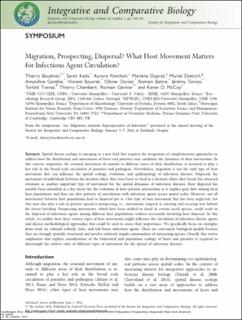| dc.contributor.author | Boulinier, Thierry | |
| dc.contributor.author | Kada, Sarah | |
| dc.contributor.author | Ponchon, Aurore | |
| dc.contributor.author | Dupraz, Marlène | |
| dc.contributor.author | Dietrich, Muriel | |
| dc.contributor.author | Gamble, Amandine | |
| dc.contributor.author | Bourret, Vincent | |
| dc.contributor.author | Duriez, Olivier | |
| dc.contributor.author | Bazire, Romain | |
| dc.contributor.author | Tornos, Jéremy | |
| dc.contributor.author | Tveraa, Torkild | |
| dc.contributor.author | Chambert, Thierry | |
| dc.contributor.author | Garnier, Romain | |
| dc.contributor.author | McCoy, Karen D. | |
| dc.date.accessioned | 2023-05-12T12:38:26Z | |
| dc.date.available | 2023-05-12T12:38:26Z | |
| dc.date.created | 2017-03-01T12:26:04Z | |
| dc.date.issued | 2016 | |
| dc.identifier.citation | Integrative and Comparative Biology. 2016, 56 (2), 330-342. | en_US |
| dc.identifier.issn | 1540-7063 | |
| dc.identifier.uri | https://hdl.handle.net/11250/3067803 | |
| dc.description.abstract | Spatial disease ecology is emerging as a new field that requires the integration of complementary approaches to address how the distribution and movements of hosts and parasites may condition the dynamics of their interactions. In this context, migration, the seasonal movement of animals to different zones of their distribution, is assumed to play a key role in the broad scale circulation of parasites and pathogens. Nevertheless, migration is not the only type of host movement that can influence the spatial ecology, evolution, and epidemiology of infectious diseases. Dispersal, the movement of individuals between the location where they were born or bred to a location where they breed, has attracted
attention as another important type of movement for the spatial dynamics of infectious diseases. Host dispersal has notably been identified as a key factor for the evolution of host–parasite interactions as it implies gene flow among local host populations and thus can alter patterns of coevolution with infectious agents across spatial scales. However, not all movements between host populations lead to dispersal per se. One type of host movement that has been neglected, but that may also play a role in parasite spread is prospecting, i.e., movements targeted at selecting and securing new habitat for future breeding. Prospecting movements, which have been studied in detail in certain social species, could result in
the dispersal of infectious agents among different host populations without necessarily involving host dispersal. In this article, we outline how these various types of host movements might influence the circulation of infectious disease agents and discuss methodological approaches that could be used to assess their importance. We specifically focus on examples from work on colonial seabirds, ticks, and tick-borne infectious agents. These are convenient biological models because they are strongly spatially structured and involve relatively simple communities of interacting species. Overall, this review
emphasizes that explicit consideration of the behavioral and population ecology of hosts and parasites is required to disentangle the relative roles of different types of movement for the spread of infectious diseases. | en_US |
| dc.language.iso | eng | en_US |
| dc.title | Migration, prospecting, dispersal? What host movement matters for infectious agent circulation? | en_US |
| dc.type | Peer reviewed | en_US |
| dc.type | Journal article | en_US |
| dc.description.version | publishedVersion | en_US |
| dc.rights.holder | © 2016 The Authors | en_US |
| dc.subject.nsi | VDP::Matematikk og Naturvitenskap: 400::Zoologiske og botaniske fag: 480 | en_US |
| dc.source.pagenumber | 330-342 | en_US |
| dc.source.volume | 56 | en_US |
| dc.source.journal | Integrative and Comparative Biology | en_US |
| dc.source.issue | 2 | en_US |
| dc.identifier.doi | 10.1093/icb/icw015 | |
| dc.identifier.cristin | 1454970 | |
| dc.relation.project | Andre: ANR-11-BSV7-003 | en_US |
| dc.relation.project | Andre: ANR-13-BSV7-0018 | en_US |
| dc.relation.project | French Polar Institute: n8333 | en_US |
| dc.relation.project | French Polar Institute: n81151 | en_US |
| dc.relation.project | National Research Foundation, South Africa: NRF - N00595 | en_US |
| cristin.unitcode | 7511,4,0,0 | |
| cristin.unitname | Tromsø | |
| cristin.ispublished | true | |
| cristin.fulltext | original | |
| cristin.qualitycode | 1 | |
